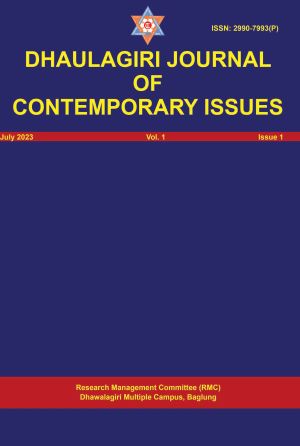Chemical analysis of the Triticum aestivum Cropped Soil
DOI:
https://doi.org/10.3126/djci.v1i1.58629Keywords:
pH, Macronutrients and Micronutrients, Soil electrical conductivityAbstract
Triticum aestivum commonly known as wheat. Simple random sampling method was used for collection of samples from twenty different locality of Tarakhola Rural Municipality-1, Majhakharka. The chemical compositions (NPK, Zn, B, and organic matter), EC and pH of Tarakhola Rural Municipality had been investigated. The micronutrients (Zinc and Boron) were determined by using Spectrophotometer and Colorimetric method. Nitrogen, Phosphorous and Potassium were analyzed by Kjeldahal method, Flame Photometer method, Modified Olsen's bicarbonate method respectively. Organic matter was determined by Calorimeter. Nitrogen- 0.57%, Phosphorus-29.05 ppm (65.08kg/hector), Potash-159.68 ppm (357.69kg/hector), organic matter-3.57%. pH is 6.4 which is suitable pH for wheat crop, Electrical conductivity is 0.087ds/m (87 milisimen), Zinc-0.54 ppm, Boron is 0.01 ppm. Organic matter and Nitrogen were medium but P and K were maximum and Zn and B were minimum.
Downloads
Downloads
Published
How to Cite
Issue
Section
License
Copyright (c) 2023 Narendra Pratap Singh Budhathoki, Shyam Gaire

This work is licensed under a Creative Commons Attribution-NonCommercial 4.0 International License.
This license allows others to use, distribute, and build upon your work, as long as they provide attribution to you as the original creator. However, the license restricts commercial use of the work, meaning others cannot use it for commercial purposes without seeking additional permissions or licensing agreements.




